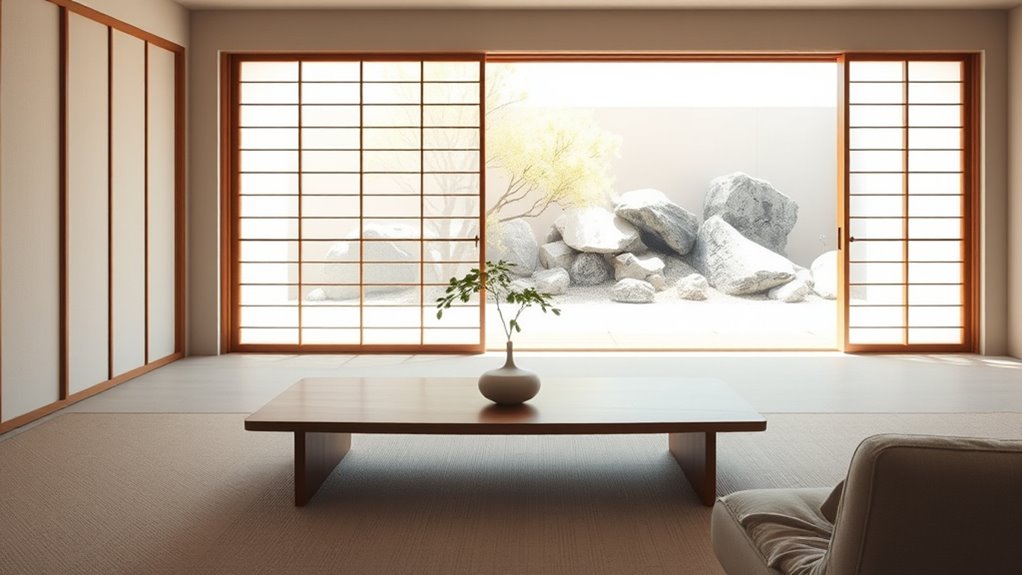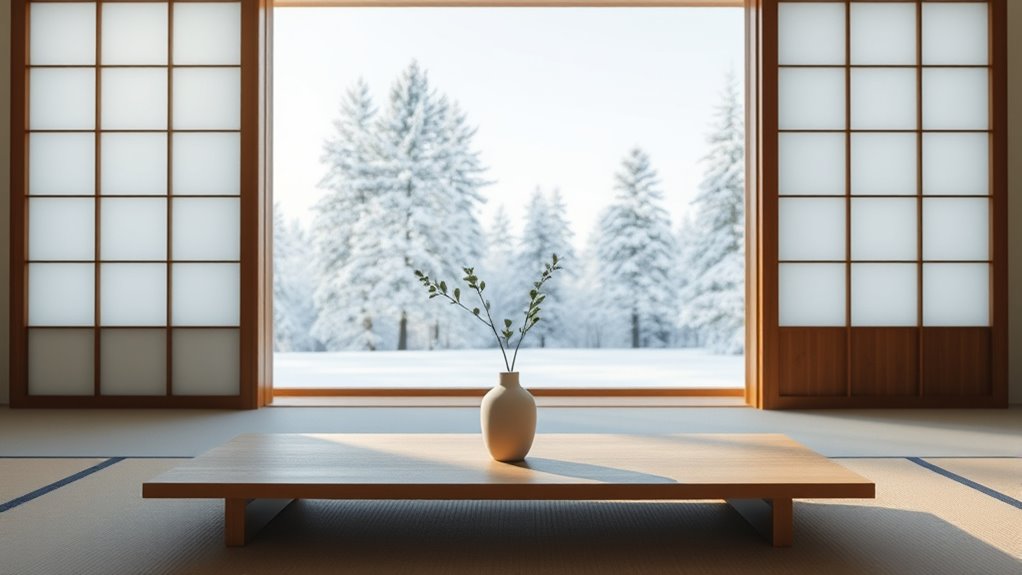Exploring minimalism across cultures reveals valuable lessons about purpose and harmony. In Japan, Zen influences promote tranquility through uncluttered spaces and natural materials. Scandinavia emphasizes functionality, comfort, and connection to nature, creating warm, inviting environments. Indian minimalism merges spiritual practices with simplicity, fostering inner serenity. Western minimalism focuses on modern design, emphasizing form and function. Continuing this journey, you’ll discover how these diverse approaches can inspire a more intentional, balanced lifestyle tailored to your needs.
Key Takeaways
- Different cultures interpret minimalism through unique lenses, such as Zen Buddhism in Japan and functionality in Scandinavia.
- Japanese minimalism prioritizes harmony, natural materials, and intentional living, emphasizing “Ma” or negative space.
- Scandinavian minimalism focuses on practicality, comfort, and connection to nature with light colors and quality craftsmanship.
- Indian minimalism integrates spiritual practices, highlighting inner serenity over material possessions.
- Despite cultural differences, minimalism universally promotes intentionality, purpose, and removing non-essentials for a balanced life.

Have you ever wondered how different cultures embrace minimalism in their daily lives? It’s fascinating to see how cultural influences shape the way people simplify spaces and routines. Different societies develop unique design philosophies based on their values, history, and environment, which ultimately influence their approach to minimalism. For example, in Japan, minimalism is deeply rooted in cultural influences stemming from Zen Buddhism, emphasizing tranquility, balance, and mindfulness. Their design philosophies focus on creating harmony between people and their environment, often through clean lines, natural materials, and uncluttered spaces. These principles encourage intentional living, where every object has a purpose and excess is avoided. The concept of “Ma,” or negative space, plays a pivotal role, allowing rooms to breathe and fostering a sense of calm. Additionally, the importance of authentic storytelling in design helps reinforce cultural identity and values within minimalist spaces.
In Scandinavian countries, minimalism is driven by a different set of cultural influences—namely, a love for functionality, comfort, and connection to nature. Their design philosophies prioritize practicality while maintaining aesthetic simplicity. Expect to see lots of light, neutral colors, and natural textures that reflect their environment. Scandinavian minimalism isn’t just about decluttering; it’s about creating spaces that promote well-being and ease of use. The focus on craftsmanship and quality reflects their cultural values, making every piece serve a purpose without unnecessary ornamentation. This approach results in homes that feel warm, inviting, and serene, emphasizing the idea that less truly is more.
Moving beyond Japan and Scandinavia, you’ll find that other cultures also have their unique takes on minimalism. In parts of India, for instance, minimalism often merges with spiritual practices, emphasizing inner serenity over material possessions. Meanwhile, Western interpretations of minimalism sometimes lean into modern aesthetics, influenced by design philosophies like Bauhaus, which prioritize function and form over decoration. These cultural influences lead to diverse expressions of minimalism, but the core idea remains consistent: stripping away the non-essential to focus on what truly matters.
Understanding these different cultural influences and design philosophies gives you a broader perspective on minimalism. It’s not just about having fewer things; it’s about cultivating a mindset that values intentionality, harmony, and purpose. Whether you’re inspired by the Zen-inspired simplicity of Japan or the cozy functionality of Scandinavian design, adopting minimalist principles can help you create a space—and a life—that’s more mindful, balanced, and fulfilling.
Frequently Asked Questions
How Does Minimalism Influence Mental Health Globally?
Minimalism positively impacts your mental health worldwide by encouraging mindfulness practices and clutter reduction. When you simplify your surroundings, you reduce stress and create a calmer environment. This clarity helps you focus on what truly matters, boosting your overall well-being. Embracing minimalism allows you to cultivate a sense of control, foster peace, and improve your mental resilience, no matter where you are.
Are There Any Economic Benefits to Adopting Minimalism?
You might think minimalism limits spending, but it actually boosts your financial health. By embracing minimalism, you reduce costs through less clutter and unnecessary purchases, leading to significant cost reduction. Plus, you become more resource efficient, saving money over time. This approach not only benefits your budget but also promotes sustainable living. So, adopting minimalism can be a smart economic move, helping you save more and live better.
How Do Cultural Values Shape Minimalist Design Choices?
Cultural values deeply influence your minimalist design choices through cultural symbolism and aesthetic preferences. You might prioritize simplicity to reflect humility or focus on natural materials that symbolize harmony with nature. These cultural influences guide your selection of clean lines, functional spaces, and understated decor, making your environment resonate with your cultural identity. By embracing these values, your minimalist design becomes a meaningful expression rooted in your cultural background.
Can Minimalism Adapt to Different Climate Conditions?
You bet minimalism can adapt to any climate, and it’s like a chameleon changing colors! By prioritizing climate adaptation, minimalist designs can incorporate insulation, natural light, or ventilation suited to hot, cold, or humid environments. This approach reduces environmental impact by cutting energy use and waste. So, whether you’re in a tropical rainforest or Arctic tundra, minimalism molds itself beautifully, proving that less is more across all climates.
What Role Does Technology Play in Minimalist Lifestyles Worldwide?
Technology plays a key role in your minimalist lifestyle by enabling tech integration that simplifies daily tasks and reduces clutter. You can focus on what truly matters by practicing digital decluttering—deleting unnecessary apps, emails, and files. This helps you create a cleaner, more intentional digital environment, supporting your minimalist goals. Embracing these tools allows you to enjoy the benefits of minimalism without sacrificing convenience or connectivity.
Conclusion
Embracing minimalism across cultures shows you there’s more power in less than you ever imagined. From Japan’s Zen-inspired simplicity to Scandinavia’s sleek functionality, you’ll discover that clarity and calmness can transform your life faster than a lightning strike. It’s not just a trend—it’s a revolution of your mind and space. So, why not start today? Simplify, breathe, and unfasten the extraordinary potential hidden within a beautifully uncluttered life. Your journey to peace begins now—nothing less than life-changing awaits!








